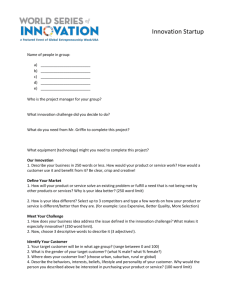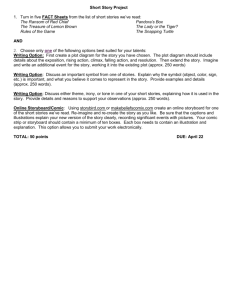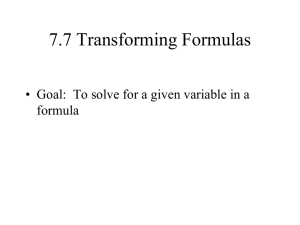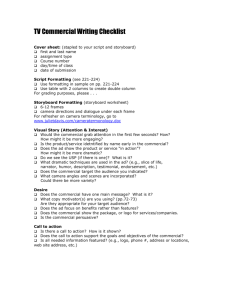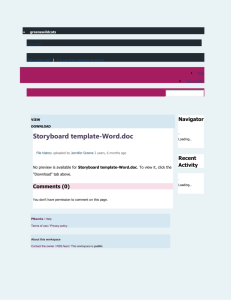Interactive Visual Histories for Vector Graphics Technical Report
advertisement
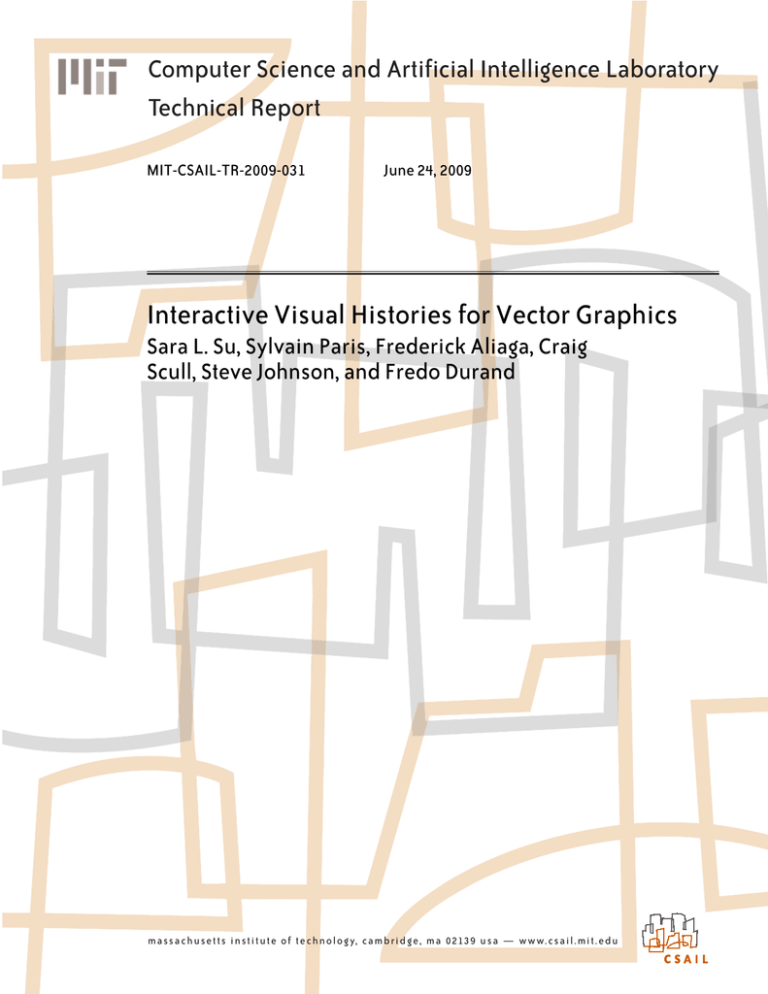
Computer Science and Artificial Intelligence Laboratory
Technical Report
MIT-CSAIL-TR-2009-031
June 24, 2009
Interactive Visual Histories for Vector Graphics
Sara L. Su, Sylvain Paris, Frederick Aliaga, Craig
Scull, Steve Johnson, and Fredo Durand
m a ss a c h u se t t s i n st i t u t e o f t e c h n o l o g y, c a m b ri d g e , m a 02139 u s a — w w w. c s a il . mi t . e d u
MIT Computer Science and Artificial Intelligence Laboratory Technical Report
Interactive Visual Histories for Vector Graphics
Sara L. Su Massachusetts Institute of Technology
Sylvain Paris Adobe Systems
Frederick Aliaga Adobe Systems
Craig Scull Adobe Systems
Steve Johnson Adobe Systems
Frédo Durand Massachusetts Institute of Technology
June 2009
ABSTRACT
Presentation and graphics software enables users to experiment with variations of illustrations.
They can revisit recent editing operations using the ubiquitous undo command, but they are limited
to sequential exploration. We propose a new interaction metaphor and visualization for operation
history. While editing, a user can access a history mode in which actions are denoted by graphical
depictions appearing on top of the document. Our work is inspired by the visual language of
film storyboards and assembly instructions. Our storyboard provides an interactive visual history,
summarizing the editing of a document or a selected object. Each view is composed of action
depictions representing the user’s editing actions and enables the user to consider the operation
history in context rather than in a disconnected list view. This metaphor provides instant access to
any past action and we demonstrate that this is an intuitive interface to a selective undo mechanism.
1 INTRODUCTION
Digital tools have introduced great flexibility to the illustrator’s workflow. In addition to providing
a rich toolbox of graphical elements, programs such as Adobe Illustrator, Corel Draw, and Microsoft PowerPoint facilitate exploration, trial-and-error editing, and refinement of designs. We
aim to add to the flexibility of these interactions by leveraging the editing history of an illustration.
All modern text and graphics editors support a notion of history. The standard undo mechanism
not only makes it easy to discard recent mistakes, it allows the user to compare the design before
and after a modification. In many programs, this has been extended to storing the full history of
actions, and users can roll back to arbitrary points in time. However, users are limited to sequential
and causal exploration of this history. We argue that the creative process, which is often inherently
nonlinear, should be supported by tools that are nonlinear. We present a new visualization that
shows the actions in context and enables nonlinear exploration of history.
We show the illustration’s history as a storyboard annotated with action depictions, graphical
metaphors of editing actions such as fill color changes or spatial transformations (Figure 1). Our
graphical history mode can be activated at any time during the editing process, and once activated,
action depictions appear on top of the document. Users can view the history of the entire document
or restrict it to a particular object or region.
1
Original Illustration
The user edits
the illustration by
rotating, translating,
and changing the
color of objects.
Our Storyboard: Global Editing History
History of
User Edits
Final Illustration
Figure 1: This automatically-generated visualization shows the editing history of an illustration. Arrows and icons
depict spatial transforms and color change actions performed by the user. The user can click on any depiction
to selectively undo the corresponding action.
1.1 Related Work
There has been much work on the history of web pages [19], graphic art [24], and datasets [14].
Our work follows most closely from the Chimera system [20, 21], which shows graphical history
in a series of panels, each one containing the before and after of an action. Chimera depicts
several “actions” in the sense that the object selection or caret placement is displayed at the same
time as the illustration modification (translation, color change, etc.). The action is described by a
text annotation. Our approach further develops the graphical aspect of the visualization, showing
multiple actions at the same time and representing them by in-place graphical depictions rather
than text annotations. We propose this fully graphical storyboard as an alternative, complementary
visualization.
Recently, Nakamura and Igarashi [25] presented a system extending the visualization methods of
Kurlander [21] and Su [27] to generic Java AWT/Swing applications. While they focus on visualizing GUI events, such as mouse movement, we focus on visualizing changes to the document and
assisting the user’s spatial memory of it.
We will discuss an application of the storyboard, using visual histories as an interface to nonsequential undo. The Photoshop history panel and SolidWorks object tree have shown the value of
maintaining and editing visual histories, and there has been significant progress made in 3D modeling and CAD [12, 7, 8, 9, 26]. The object tree in CAD systems provides a convenient interface
for selective undo and parametric changes but requires significant structuring of the document. We
want to offer some of the flexibility of these systems at a lower overhead to the user. Unlike the
typical CAD file, illustrations in presentation slides are often done by casual users who are unlikely
to create any hierarchy.
1.2 Overview
Our storyboard is a visualization, as well as a new mode of interaction with a document’s operation
history. We describe how our storyboard interface enables non-sequential browsing and modification of a graphical content. We see the storyboard as complementary to existing interaction
methods, and its visual histories are intuitive on the scale of the typical 2D vector illustration. In
2
a usability study (Section 5), subjects easily understood how the storyboard relates to their actions
and appreciated the new interaction modes. We target moderate complexity drawings on the scale
of a typical clipart or PowerPoint illustration, which covers a large set of users. Comments from
study participants also informed the design of extensions to the visualization (Section 6).
2 DESIGN GOALS
We have designed the storyboard annotations to be simple, with a common look and feel. The action depictions follow the visual language of assembly instructions [2], maps [3], comics, and film
storyboards. Together, the depictions can be seen as the “assembly instructions” for a document.
Principles from cognitive psychology [31, 29] inform our design strategy, summarized below.
Sequence of discrete steps. Humans naturally interpret and remember an event as a sequence
of discrete steps [32], and it has been shown that diagrams reflecting this structure are easier to
comprehend [2, 15]. Our approach naturally achieves such sequential structure since the history of
a vector graphics documents is a list of discrete steps. We refer to these steps as actions.
In place, static visualization. Our interface allows the user to consider actions in spatial context.
It has been shown that in-place visualization of user interface transitions [4] and variations [28]
improve comprehension by exploiting spatial memory. Continuous changes over time, such as
dragging an object to translate it, could be depicted with animated visualizations. However, because experiments on the effectiveness of animation in explanatory diagrams are inconclusive [30],
we use static visualizations. Furthermore, one function of the storyboards is to enable users to select actions to undo, and a moving target could increase acquisition time.
Congruence, proximity, and comprehension. Most editing actions are visual in nature, and we
rely on well-accepted schematic representations, such as an arrow for a translation [31]. We have
designed these visual elements to have a consistent look, exploiting the drawing primitives of the
editing software itself.
Pilot users commented that “detached” icons were difficult to understand. In our storyboard, an
action depiction is directly in contact with the object upon which it acts, e.g. a change of color is
represented by a paint bucket overlaid on the object, visually relating the action to the object. We
ghost unmodified regions to draw focus to objects actively being edited.
Before and after. We enable the user to compare the before and after states of a drawing in order
to facilitate the decision to undo it or not. For example, we show the locations of an object before
and after a translation, with “before” states rendered semi-transparent and in-place to limit screen
clutter.
Summarization. A single depiction limits the information provided to the user. Inspired by recent work on “reverse storyboarding” [10, 11], we summarize a segment of history with multiple
depictions per view. Our interface shares some of the annotation elements, but while these storyboards visualize an existing video sequence as a static image, our goal is to visualize the steps
of constructing an illustration. To alleviate the visual clutter that can result from storyboarding a
complicated document history, we support a “magic lens” interface [6, 16] for viewing the history
of a selected object. User evaluation confirms that restricting the scope of the visualization is the
preferred mode of interaction.
3
3 STORYBOARD VISUALIZATION
We provide a graphical history mode that can be activated at any time when editing an illustration
document. Our algorithm takes the operation history and creates a storyboard by traversing it
from present to past. For each type of action, we have designed an action depiction, a visual
representation automatically generated based on the parameters of the action and the set of objects
it acts on. For instance, a translation of a polygon is depicted with a straight arrow. The action
depictions are overlaid on the illustration. Among the challenges we address are designing visual
metaphors to facilitate user comprehension and laying them out to minimize clutter.
3.1 Action Depictions
Our software prototype supports common actions on shapes, paths, and text. The actions we
depict fall into the following categories: creations and deletions, spatial transforms, change of
scale, fill and stroke attribute changes, and control point edits. Every action is responsible for its
visualization. We have designed the action depictions with a common look and feel and display
them in a layer on top of the illustration to help them stand out.
We depict translation and rotation using arrows that share a similar
visual style. We use thin arrows to avoid hiding the main illustration.
Each arrow carries an icon indicating the transformation type. This icon
also provides a target easy to click. The arrows have a constant thickness
to represent rigid transformations and a white outline to ensure visibility
on any background.
For translations, we use straight arrows between the object’s old and new positions. The rotation
arrow is similar; its length and orientation are the magnitude and direction of the transform. The
arc shares the object’s center of rotation and its radius is the larger dimension of the object. For
very small changes, such as keyboard “nudges”, we enforce a minimum arrow length.
The resizing depiction uses one to four axis-aligned arrows. To visually distinguish between scaling up and down and between scaling and other transforms, we use wide,
tapered arrows: narrow-to-wide for up-scaling and wide-to-narrow for down-scaling.
Editing of control points, often used for refinement involving a series of many, in-place
adjustments, is simply shown with the before and after states.
We depict changing fill and stroke style by overlaying a partial representation of the
previous state on top of the current one. In practice, to create this half-object, we first
create a cutting path as the diagonal half of the “after” object’s bounding box. We then
take the Boolean difference of the object and the cutting triangle and overlay the result
on the full “before” object. We complement the before/after overlay with icons, placed
according to congruence rules, to provide an additional cue as to the type of change.
Unlike other actions, creation and deletion do not affect any transformation on the object’s shape, position, or appearance style. Creation is easily identified due to the sequential appearance of the depictions, but for deletion we compensate by using an iconic cue.
A gray, semi-transparent copy with an “X” icon represents a deleted object.
4
3.2 History in Context
Our storyboard provides an interactive visual history of a document, shown either as a summarizing global storyboard or a local storyboard for a selected object. From discussions with user
experience designers, we understand that providing both modes of interaction provides the best
support for common producer (editing) and consumer (viewing) tasks.
The storyboard can be activated at any time during the editing process. Action depictions appear
on top of the document, and users can select them to undo the corresponding actions. This allows
the user to consider the actions in spatial context rather than in a disconnected list view. This
visualization provides a natural interface to a selective undo mechanism.
Figure 2: Per-object history. The user can restrict the history view (Figure 1) to a selected object.
3.3 Alternative Styles
A possible extension is to offer several depiction sets so that users can select a style not conflicting
with their own illustration. For instance, movie makers would appreciate thick 3D arrows typical
from movie storyboards [13]. Figure 6 shows such a style, which we have considered in our
preliminary studies. In this paper, we focus on the “thin arrow + icon” style since it minimizes
clutter and fits well to most illustrations.
4 APPLICATION: NON-SEQUENTIAL UNDO
Sequential undo, found in all existing illustration programs, removes the latest action from the top
of the undo stack. To return to a previous state, the user has no choice but to lose all actions between
then and the current state. A number of techniques have been proposed for less destructive, nonsequential undo mechanisms [5, 24, 22, 18]. We show that a useful application of our storyboard is
as a front-end to non-sequential undo. The user can click on the depiction for any previous action
to index into the history. Any action, not only the most recent one, can be undone. We briefly
describe our use of storyboards for non-sequential undo in vector graphics editing.
5
Final Illustration
Original Illustration
The user edits
the illustration
(copy/paste, move,
rotate, color)
Storyboard visualization of global editing history
(a) The storyboard summarizes the user’s edits between the
two versions of the illustration, showing these edits in spatial
context.
Updated storyboard after selective undo
(b) This storyboard shows the state of the document after the
user has selectively undone the translation of the earring.
Figure 3: The storyboard visualization provides a natural interface for non-sequential interaction, specifically
selective undo. Note that the selective undo of the earring movement (an action occurring farther back in the
history stack) does not affect any other object. In contrast, standard (sequential) undo would have required also
undoing all subsequent actions.
4.1 Dependencies
We observe that many editing actions can be considered independently from each other. First, an
action on one object can be safely undone without affecting actions on different objects. Second,
we define the following dependency classes,
• Spatial transforms = {translation, rotation}
• Appearance changes = {fill style, stroke style}
• Shape modifications = {control point editing, resizing}
and argue that an action can be considered orthogonal to any action that does not belong to its
class. We found that, in practice, these definitions are easy to understand. We keep as future work
the study of alternative classes, e.g. setting fill and stroke independent.
6
Illustration
The user
has been
drawing in
Inkscape.
Illustration
He picks
the edit
to undo.
In order to
undo a prior
edit, he enters
per-object
history mode.
He continues
editing the
drawing.
Storyboard
Storyboard
Storyboard
Illustration
The user
exits history
mode and
continues
editing.
The undo
does not
affect the
rest of the
drawing.
Figure 4: Participants in the user study were asked to recreate drawings from their personal experiences. Over
the course of the editing sessions, they were asked to make modifications to their drawings in an effort to
enourage the use of the visualization and undo.
4.2 Algorithm
Non-sequential undo is less destructive because, rather than canceling all actions after the selected
one, it cancels only those acting on the same object that also belong to the same class. We execute
a non-sequential undo command by issuing a number of queries to the undo stack. First, given
the action depiction the user selected, we retrieve from the corresponding entry in the undo stack
a list of objects affected by that action. Then, we query the stack for a list of actions subsequent
to the undone actions that affected any of those objects. Among these actions, only those of the
same class as the undone action are canceled. Figure 3 shows an example of the storyboard as an
interface to selective undo.
5 USABILITY STUDY
We have implemented the storyboards and non-sequential undo as an extension to the vector graphics editor Inkscape [17]. Our implementation reuses Inkscape drawing primitives to display the storyboard and create action depictions. We conducted a concept evaluation by observing first-time
users of our prototype.
User interaction with drawing tools is by nature complex. This suggests that using a standardized
task for quantitative analysis would require a great simplification of this interaction. Rather than
comparing measurements such as success rates or task completion times, we asked participants
to recreate drawings from their typical use and performed a qualitative analysis by interviewing
participants and extracting recurring themes.
7
5.1 Participants and Apparatus
Twelve participants (6 male, 6 female) aged 20-40 years were recruited for the study and received
a gratuity for their time. Half were proficient computer users from a university and half were from
the broader community. Some had familiarity with Illustrator; all were familiar with the drawing
tools in PowerPoint. The university participants had prior experience creating figures for papers
or presentations, and the participants from the community had a wide range of experience. None
were graphic designers or creative professionals, and one was casually familiar with Inkscape.
Subjects used a computer running Windows XP, with a display at 1280 × 1024 pixel resolution.
Our modified version of Inkscape, with history storyboard and non-sequential undo extensions,
was used for all drawing tasks. We removed all non-essential widgets.
5.2 Design
First, participants were asked about their background: occupation, types of drawings normally
made, and tools used. Second, they were given a short tutorial on Inkscape and the history features
and then asked to create one of the drawings they had described earlier. During the drawing
task, participants were encouraged to try out the new history functions. Finally, participants were
interviewed about their experience to record subjective preferences.
5.3 Results
Participants were asked to recreate drawings typical for them, resulting in a diverse sample of illustrations. Some are shown in Figures 4 and 8. Despite the wide range of participant backgrounds
and drawing experiences, themes emerged from the interviews.
Free experimentation (nonlinear working style). Participants said that, compared to the tools
they normally use, the storyboard allowed them to more freely experiment and try out new ideas.
Participants often made a series of precise alignments, pixel-level adjustments, and precise color
changes which would have been tedious to recreate in a traditional history that undoes every change
after the one selected.
Spatial memory cues. Some participants commented that visualization of the history helped
them to recall previously made changes, which they found helpful to reconsider.
Persistent history. Some participants described past situations in which they would have wanted
to revert to changes from prior working sessions. One participant said, “I have accidently made
changes to a file before, saved it over top of the original and then had no way to retrace steps to the
original version.”
Limitations. A common request was a shortcut or contextual menu for the undo functions. We
had disabled these features for the study to avoid bias. Several participants reported being overloaded by the number of depictions in the global storyboard or felt that the history got in the way
of the illustration; they would have liked a means to view their “pristine” drawing. We expected
these comments as our approach deliberately adds visual depictions on top of the drawing. To
address these reactions, we added a shortcut to swap between the history and “pristine” views, and
developed the extension described in the following section.
8
6 EXTENSIONS
6.1 Multi-Frame Storyboards
A long illustration session can generate a dense storyboard when all actions are displayed at the
same time. On the other hand, showing singular actions limits the information provided to the user.
User feedback confirmed the need for balance in the visualization. We propose a hybrid storyboard
that shows multiple actions per view or frame.
To create this multi-frame storyboard (Figure 6), we traverse the history stack from the most recent
action. We use a greedy strategy to avoid visual clutter when generating the depictions. If adding
the next depiction would fully obscure an existing one or overlap more than a set maximum number
of existing ones, we create a new frame; otherwise we draw in the current one. In addition to the
visibility rule, we set a maximum number of depictions per frame. The viewport and zoom level
are set so that all depictions and the objects they affect are visible. In addition, we set minimum
and maximum zooms as functions of the overall drawing size.
D RAW M ULTI F RAME S TORYBOARD (HistoryStack H):
1. For each action a in H:
(a) Create a new action depiction da .
(b) ia = number of intersections of da with depictions in the current frame.
(c) If da fully obscures any existing depiction or if ia > maxIntersections:
i. Create a new frame.
ii. Set the current frame to be the new frame.
(d) Draw da in the current frame.
(e) Adjust the zoom level.
Figure 5: Pseudo-code of the multi-frame storyboard creation process.
Figure 6: Multi-frame storyboard. This storyboard summarizes the editing history of a document, with time
progressing from left to right. In addition, this storyboard shows an alternative depiction style we have considered.
9
6.2 Editing in Multiple-User Environments
The storyboard facilitates editing by multiple users in a manner similar to the “track changes”
feature available in text editors such as Microsoft Word. Every editing action is tagged with the
ID of the current user. In the storyboard, actions are color-coded by author, making visible the
interactions between all the collaborators (Figure 7). This could, for example, assist multiple
authors working on the same figure for a paper. Currently, we support asynchronous collaboration
across several editing sessions. Synchronous editing raises new challenges for undo that are worth
investigating, including user understanding of the undo mechanism and user intent [1].
Alice
Bob
Figure 7: Collaborative editing scenario. Two users have edited this drawing, and the storyboard displays their
actions color-coded in a “track changes” style.
7 DISCUSSION
Our storyboard visualization can help users take fuller advantage of design on the computer by
making the process more flexible and by helping them explore alternative versions of their designs.
In particular, our user study has shown that people appreciate the additional freedom afforded by
this interface to selective undo and that our storyboard aids their comprehension of the creation
process as a whole, beyond the currently displayed illustration.
Storyboards encourage exploratory design by enabling the user to easily survey previous actions
in spatial context and selectively undo them. An interesting direction for future work is to improve
storyboards with design galleries [23] or other systems for visualizing variations to further facilitate prototyping. Another promising application is instruction. An expert’s storyboards could act
as tutorials by revealing the editing process. While we have shown applications in vector graphics editing, we believe that these visualization techniques could be extended to aid prototyping,
collaboration, and instruction in other domains.
10
Figure 8: A sampling of vector drawings made by participants in our study. All were amateurs who had prior
experience with Microsoft PowerPoint’s drawing tools, and some were familiar with Adobe Illustrator. All were
first-time users of our software, yet were able to create a wide range of drawings in a short period of time.
ACKNOWLEDGMENTS
The authors wish to thank the MIT Graphics Group, Steve Feiner, and Mira Dontcheva for discussion, the developers of Inkscape, and the maintainers of the Open Clip Art Library. Frédo Durand
acknowledges a Microsoft Research New Faculty Fellowship, a Sloan Fellowship, and a generous
gift from Adobe. This work was partially funded by the Singapore-MIT GAMBIT Game Lab.
REFERENCES
1. G. D. Abowd and A. J. Dix. Giving undo attention. Interacting with Computers, 4(3):317–342, 1992.
2. M. Agrawala, D. Phan, J. Heiser, J. Haymaker, J. Klingner, P. Hanrahan, and B. Tversky. Designing effective
step-by-step assembly instructions. ACM Transactions on Graphics (Proc. SIGGRAPH), 22(3):828–837, 2003.
3. M. Agrawala and C. Stolte. Rendering effective route maps: Improving usability through generalization. In
Proceedings of ACM SIGGRAPH 2001, Computer Graphics Proceedings, Annual Conference Series, pages 241–
250, Aug. 2001.
4. P. Baudisch, D. Tan, M. Collomb, D. Robbins, K. Hinckley, M. Agrawala, S. Zhao, and G. Ramos. Phosphor:
explaining transitions in the user interface using afterglow effects. In UIST ’06: Proceedings of the 19th ACM
Symposium on User Interface Software and Technology, pages 169–178, 2006.
5. T. Berlage. A selective undo mechanism for graphical user interfaces based on command objects. ACM Transactions on Computer-Human Interaction, 1(3):269–294, 1994.
6. E. A. Bier, M. C. Stone, K. Pier, W. Buxton, and T. D. DeRose. Toolglass and magic lenses: The see-through
interface. Computer Graphics (Proceedings of SIGGRAPH 93), 27:73–80, 1993.
7. M. Bussan and R. Hall. Abstraction, context and constraint. In State of the Art in Computer Graphics. SpringerVerlag, 1993.
8. V. A. Cicirello and W. C. Regli. Resolving non-uniqueness in design feature histories. In SMA ’99: Proceedings
of the fifth ACM symposium on Solid modeling and applications, pages 76–84, 1999.
9. V. A. Cicirello and W. C. Regli. Managing digital libraries for computer-aided design. Computer Aided Design,
32(2):119–132, 2000.
10. R. D. Dony, J. W. Mateer, J. A. Robinson, and M. G. Day. Iconic versus naturalistic motion cues in automated
reverse storyboarding. In Proceedings of 2nd IEEE European Conference on Visual Media Production, pages
17–25, 2005.
11. D. B. Goldman, B. Curless, D. Salesin, and S. M. Seitz. Schematic storyboarding for video visualization and
11
12.
13.
14.
15.
16.
17.
18.
19.
20.
21.
22.
23.
24.
25.
26.
27.
28.
29.
30.
31.
32.
editing. ACM Transactions on Graphics, 25(3):862–871, 2006.
R. Hall, M. Bussan, P. Georgiades, and D. P. Greenberg. A testbed for architectural modeling. In Proceedings of
Eurographics ’91, pages 47–58, 1991.
J. Hart. The Art of the Storyboard: Storyboarding for Film, TV, and Animation. Focal Press, 1999.
J. Heer, J. Mackinlay, C. Stolte, and M. Agrawala. Graphical histories for visualization: Supporting analysis,
communication, and evaluation. IEEE Transactions on Visualization and Computer Graphics, 14(6):1189–1196,
Nov.-Dec. 2008.
J. Heiser, D. Phan, M. Agrawala, B. Tversky, and P. Hanrahan. Identification and validation of cognitive design
principles for automated generation of assembly instructions. In AVI ’04: Proceedings of the Workshop on
Advanced Visual Interfaces, pages 311–319, 2004.
S. E. Hudson, R. Rodenstein, and I. Smith. Debugging lenses: a new class of transparent tools for user interface
debugging. In UIST ’97: Proceedings of the 10th ACM Symposium on User Interface Software and Technology,
pages 179–187, 1997.
Inkscape. www.inkscape.org, 2008.
Y. Kawasaki and T. Igarashi. Regional undo for spreadsheets. In Proceedings of the 17th Annual ACM Symposium on User Interface Software and Technology, 2004.
S. R. Klemmer, M. Thomsen, E. Phelps-Goodman, R. Lee, and J. A. Landay. Where do web sites come from?
capturing and interacting with design history. In Proceedings of CHI 2002: ACM Conference on Human Factors
in Computing Systems.
D. Kurlander and S. Feiner. A history-based macro by example system. In Proceedings of the 5th Annual ACM
Symposium on User Interface Software and Technology, pages 99–106, 1992.
D. J. Kurlander. Graphical Editing by Example. PhD thesis, Columbia University, 1993.
R. Li and D. Li. A regional undo mechanism for text editing. In Proceedings of the Workshop on Collaborative
Editing Systems, 2003.
J. Marks, B. Andalman, P. Beardsley, W. Freeman, S. Gibson, J. Hodgins, T. Kang, B. Mirtich, H. Pfister,
W. Ruml, K. Ryall, J. Seims, and S. Shieber. Design galleries: a general approach to setting parameters for
computer graphics and animation. In Proceedings of SIGGRAPH’97, pages 389–400, 1997.
C. Meng, M. Yasue, A. Imamiya, and X. Mao. Visualizing histories for selective undo and redo. In Proceedings
Third Asian Pacific Conference on Computer and Human Interaction, pages 459–464, 1998.
T. Nakamura and T. Igarashi. An application-independent system for visualizing user operation history. In UIST
’08: Proceedings of the 21st annual ACM symposium on User interface software and technology, pages 23–32,
2008.
R. Schmidt, T. Isenberg, P. Jepp, K. Singh, and B. Wyvill. Sketching, scaffolding, and inking: a visual history
for interactive 3D modeling. Proceedings of the 5th International Symposium on Non-Photorealistic Animation
and Rendering, pages 23–32, 2007.
S. L. Su. Visualizing, editing, and inferring structure in 2D graphics. In Adjunct Proceedings of UIST 2007
(Doctoral Symposium), pages 29–32, 2007.
M. Terry, E. D. Mynatt, K. Nakakoji, and Y. Yamamoto. Variation in element and action: supporting simultaneous development of alternative solutions. In CHI ’04: Proceedings of the SIGCHI Conference on Human
Factors in Computing Systems, pages 711–718, 2004.
B. Tversky, M. Agrawala, J. Heiser, P. Lee, P. Hanrahan, D. Phan, C. Stolte, and M.-P. Daniel. Applied Spatial
Cognition From Research to Cognitive Technology, chapter Cognitive Design Principles for Automated Generation of Visualizations. Lawrence Erlbaum, 2006.
B. Tversky, J. B. Morrison, and M. Betrancourt. Animation: can it facilitate? Int. J. Hum.-Comput. Stud.,
57(4):247–262, 2002.
B. Tversky, J. Zacks, P. Lee, and J. Heiser. Lines, blobs, crosses, and arrows: Diagrammatic communication with
schematic figures. In M. Anderson, P. Cheng, and V. Haarslev, editors, Theory and Application of Diagrams,
pages 221–230. Springer, 2000.
J. Zacks, B. Tversky, and G. Iyer. Perceiving, remembering and communicating structure in events. Journal of
Experimental Psychology: General, 136:29–58, 2001.
12

